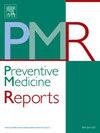COVID-19大流行期间学习模式与儿童健康行为之间的关系
IF 2.4
3区 医学
Q2 PUBLIC, ENVIRONMENTAL & OCCUPATIONAL HEALTH
引用次数: 0
摘要
目的探讨COVID-19期间学校学习模式(虚拟与面对面)与儿童健康行为(每日屏幕时间、身体活动、户外时间、睡眠持续时间和睡眠开始时间)之间的关系,以及这些关系是否受到儿童年龄、性别和家庭收入的影响。方法采用纵向队列研究对目标儿童中心4 ~ 13岁的儿童进行研究。2020年11月至2022年7月儿童和家庭COVID-19研究。目标的孩子啊!是加拿大安大略省的一个初级保健研究网络。从家长重复报告的问卷中收集社会人口特征、儿童学校学习模式和健康行为的数据。线性混合效应模型拟合调整了先验识别的混杂因素。结果患儿367例,男占51%;7.3(±2.2)年],共纳入779例学校学习模型观察。与面对面学习相比,虚拟学习与更高的每日屏幕时间相关(0.22小时;95% CI 0.03, 0.40),户外时间较长(0.71 h;95% CI 0.56, 0.86),较高的体力活动(0.64 h;95% CI 0.44, 0.85)和较晚的睡眠开始时间(0.22 h;95% ci 0.15, 0.28)。年龄较大的儿童每天的户外活动时间更长,女孩的睡眠时间更晚,家庭收入超过15万美元的儿童每天的体育锻炼时间更长。结论虚拟学习与流感大流行期间每天屏幕时间、户外活动时间和身体活动时间增加以及睡眠时间推迟有关。本文章由计算机程序翻译,如有差异,请以英文原文为准。
The association between learning models and child health behaviours during the COVID-19 pandemic
Objective
This paper aimed to explore the association between school learning models (virtual vs. in-person) and child health behaviours (daily screen time, physical activity, outdoor time, sleep duration, and sleep onset time) during COVID-19, and whether these associations were modified by child's age, sex, and family income.
Methods
A longitudinal cohort study was conducted among children four to 13 years from the TARGet Kids! COVID-19 Study of Children and Families between November 2020 and July 2022. TARGet Kids! is a primary care research network in Ontario, Canada. Data on sociodemographic characteristics, child school learning models and health behaviours were collected from repeated parent-reported questionnaires. Linear mixed effects models were fit adjusting for confounders identified a priori.
Results
A total of 367 children [51 % male; 7.3 (± 2.2) years] with 779 observations on school learning model were included. Compared to in-person learning, virtual learning was associated with higher daily screen time (0.22 h; 95 % CI 0.03, 0.40), higher outdoor time (0.71 h; 95 % CI 0.56, 0.86), higher physical activity (0.64 h; 95 % CI 0.44, 0.85), and a later sleep onset time (0.22 h; 95 % CI 0.15, 0.28). Older children had higher daily outdoor time, girls had a later sleep onset time and children with a family income greater than $150,000 reported higher daily physical activity.
Conclusions
Virtual learning was associated with higher daily screen time, outdoor time and physical activity, and later sleep onset time during the pandemic.
求助全文
通过发布文献求助,成功后即可免费获取论文全文。
去求助
来源期刊

Preventive Medicine Reports
Medicine-Public Health, Environmental and Occupational Health
CiteScore
3.90
自引率
0.00%
发文量
353
 求助内容:
求助内容: 应助结果提醒方式:
应助结果提醒方式:


